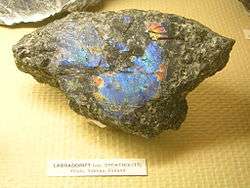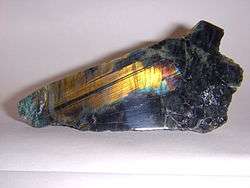Spectrolite
Spectrolite is an uncommon variety of labradorite feldspar.


Colors
Spectrolite exhibits a richer range of colors than other labradorites as for instance in Canada or Madagascar (which show mostly tones of blue-grey-green) and high labradorescence.[1][2] The term is sometimes incorrectly used to describe labradorite whenever a richer display of colors is present, regardless of locality. Due to the unique colors mined in Finland, spectrolite has become a brand name for material mined only there. Sometimes spectrolite is incorrectly used to describe labradorite whenever a richer display of colors is present, regardless of locality: for example, labradorite with the spectrolite play of colors has sometimes described material from Madagascar.[1]
Finland deposit
The difference between Finnish spectrolite and other labradorites is that crystals of the former have considerably stronger and larger colourfulness, caused by its opaque base color; other labradorites have a transparent base color. The anorthosite-dominant plagioclase from Ylämaa, Finland was named by Walter Mikkola and then accepted as a commercial name by geology professor Aarne Laitakari, then director of Geological Survey of Finland. Spectrolite is often cut as a lapidary cabochon, similar to plain labradorite, to enhance the effect and is used as a gemstone.
History
Finnish geologist Aarne Laitakari (1890–1975) described the peculiar stone and sought its origin for years when his son Pekka discovered a deposit at Ylämaa in south-eastern Finland, while building the Salpa Line fortifications there in 1940.
The quarrying of spectrolite began after the Second World War and became a significant local industry. In 1973, the first workshop in Ylämaa began cutting and polishing spectrolite for jewels. After that, a gem center was established in Ylämaa with training for gem-cutting accompanied by an annual Gem and Mineral Show initiated by Esko Hämäläinen, mayor of Ylämaa municipality.
References
Seppo Lahti I.1989 The origin of interference colours in spectrolite (iridescent labradorite).Geologi 41.
- Michael O'Donoghue, Gems, Butterworth-Heinemann, 6th ed., 2006, pp. 238-267, ISBN 0-7506-5856-8
- Walter Schumann, Gemstones of the World, Sterling, 3rd ed., 2007, pp. 52 - 53, 182 ISBN 1-4027-4016-6